On the surface of the great Lake Titicaca, you will find a cluster of almost 100 reed islands. The Uros floating islands have been around for centuries. They are like no other place on Earth.
But what made the Uros people build these islands in the first place? How do the inhabitants survive?
In this article, I will provide some insight into the history of the reed islands and give you a glimpse into floating island life in modern times. Plus, you’ll find some honest pointers on what to expect when visiting the Uros islands.
Looking for a short tour? Here are some of my favourite tours in Lake Titicaca:
- Combined Uros and Taquile Island Day Tour (leaves from Puno)
- 2-Day Budget Lake Titicaca Tour (incl. Uros, Amantani and Taquile)
- Full Day Puno Tour (incl. Lake Titicaca, Uros and Taquile)
- Floating Islands Day Tour (with lunch on Taquile)
- 2-Day Luxury Lake Titicaca Boat Tour (leaves from Cusco)
See more Lake Titicaca day tour options.
Floating Islands of Lake Titicaca
Titicaca's Reed Islands
You can find the Lake Titicaca Floating Islands just 5km (3 miles) off the lakeside town of Puno in Peru. Life on these tiny floating reed islands is uncomplicated and tranquil.
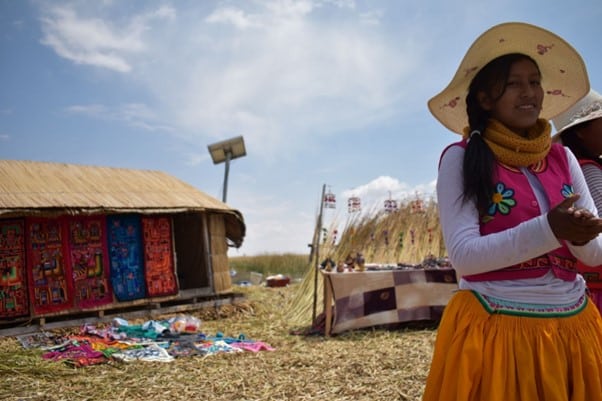
History Of Uros Islands - Lake Titicaca
The Uros people are descended from Titicaca’s most ancient tribes. Historians believe these early people migrated to the lake’s shore from Bolivia, most likely to escape droughts from 900-1200 AD.
Originally, these ancient tribes lived on the mainland near Titicaca’s shore. Around 500 years ago, the Incan Empire was expanding rapidly and invading small villages.
The Uros people realized they could build islands and escape into the deeper parts of the lake. Unfortunately, the Incas (and later the Spanish) did eventually find the Islands. Many reed-islanders were taken as slaves to build the Incan empire.
Originally, the floating islands were located well away from the mainland. In 1986, a big storm destroyed some of the islands and pushed others to the Bolivian side of the lake. After this, the Uros made a big change in their lifestyle and reallocated the islands closer to Puno.
This meant much more frequent interaction with the mainland. Over the years, the islands have focused more and more on tourism. Uros people once spoke Pukini. This language has gone extinct as island residents traded and married members of the Aymara tribe on the mainland.
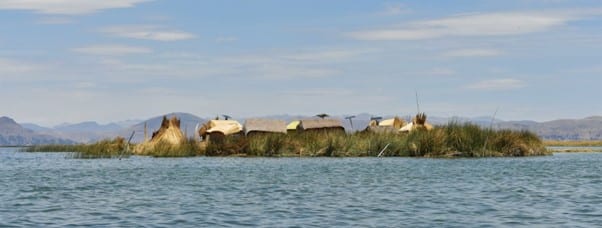
How Are Titicaca’s Floating Islands Built?
The Totoro reeds are key to life on the Uros floating islands. These reeds are similar to sedges or bullrushes and flexible, yet strong and durable.
Island construction begins with root blocks. These large clusters are easier to gather during the rainy season. They get uprooted by rising water levels and float to the surface. Root blocks can be 1-2 metres (3-6 feet thick).
These roots are stacked together, anchored down with eucalyptus stakes, and finally tied down with rope.
Reeds are harvested using a scythe-type tool. Usually, the totora is left in the sun for a few weeks to dry out. Once dry, the reeds are tied together with rope. The nylon rope is a modern change from totora, which breaks down more quickly due to the elements. Reed bundles are then stacked in a crisscross pattern on top of the blocks.
Maintaining these floating islands is a constant endeavor. Reeds rot especially fast after rainfall. Increased foot traffic from tourists also causes more compression and decay. The residents need to replace the totora reeds about once a month in the dry season. During the rainy months, new material is added weekly.
The island's surface is soft and gives way a little when you step on it. With good maintenance, an island can last 30 years.
Where to stay? Here are 7 of my favourite accommodation options on Lake Titicaca and in Copacabana:
- Los Uros Hostel (affordable and private accommodation)
- Duque Inn (private option at budget prices)
- Qelqatani Hotel (more upmarket option)
- Totora B&B (guest-house experience at backpacker prices)
- Hostal Sonia (cheap and comfortable accommodation)
- Hotel Onkel Inn Torres (pricey but with excellent views)
- Titicaca Lodge Peru (pricey but lavish accommodation)
See more Lake Titicaca and Copacabana accommodation options.
How Many Lake Titicaca Floating Islands Are There?
There are around 120 Lake Titicaca Floating Islands made entirely out of reeds. It's hard to give an exact count as new islands continue to pop up and others fall apart. Reed islands have almost doubled in quantity over the last 10 years.
There is a population of over 1000 people living on the Lake Titicaca Floating Islands. This increases as many children choose to remain on Uros. Some of the islands are as small as 4m x 4m (13 x 13 feet).
Life on Uros Floating Islands
Each island belongs to a single family and has 4-10 houses. The totora reed is the key to life on the Uros islands. The thick root mass and buoyant stems are used to build the islands, boats, and houses.
Totora - A Plant of many Uses
But that's not all the reeds are good for. You can eat the fleshy inside of the stems. You may hear it affectionately called the lake banana. The texture is a bit dry and reminiscent of non-sweet sugarcane.
Dry Totora is also burnt as fuel for cooking. The ashes can be used as an antiseptic too. Finally, you can also boil the flowers to make tea.
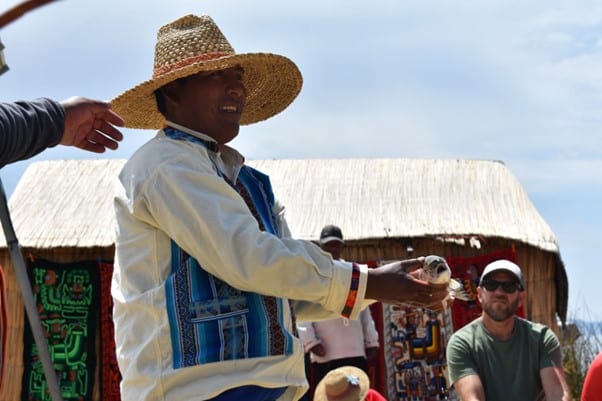
An islander shows us some of the fish caught in Lake Titicaca
What do people on Uros Floating Islands eat?
The people here rely on their environment for most of their food. Boats are essential for hunting, fishing, and getting between the islands.
Eggs are also gathered from waterbird nests amongst the reeds. Cooking is done on an outdoor fire over wet reeds - one loose spark can be catastrophic.
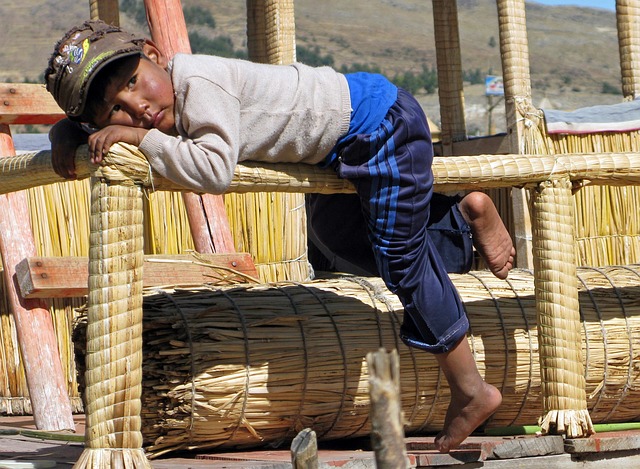
School on Lake Titicaca Floating Islands
There is a primary school on the islands. When I was there, the teacher was boating in from the mainland every day. A small motorboat acts as the school bus between the islands. Older children attend high school on the mainland.
You may also like...
How Do People on Uros Live?
Of course, the inhabitants of Uros have embraced some modern technologies. Many of the houses have solar panels. They use electricity for lights, charging phones and television. Some islands even have Wi-Fi!
It is also easy to get supplies or access medical care. Most people who live on Uros visit the mainland once a month. The only real source of income comes from selling crafts to tourists.
Looking for a short tour? Here are some of my favourite tours in Lake Titicaca:
- Combined Uros and Taquile Island Day Tour (leaves from Puno)
- 2-Day Budget Lake Titicaca Tour (incl. Uros, Amantani and Taquile)
- Full Day Puno Tour (incl. Lake Titicaca, Uros and Taquile)
- Floating Islands Day Tour (with lunch on Taquile)
- 2-Day Luxury Lake Titicaca Boat Tour (leaves from Cusco)
See more Lake Titicaca day tour options.
Visit The Titicaca Floating Islands of Titicaca
Tourists are taken on a traditional reed boat between Uros islands
One of the most popular options for visiting the Lake Titicaca Floating Islands by far is taking a day trip to the Uros Islands.
See more in our guides on tours and trips from Cusco to Lake Titicaca and Lake Titicaca activities.
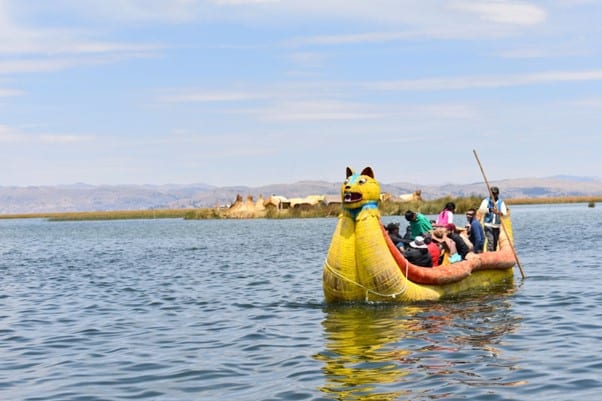
Tourists are taken on a traditional reed boat between Uros islands
Visit Uros Islands - Titicaca on a Day Trip
Titicaca’s floating reed islands are only 5km (3 miles) by boat from Puno. If you are staying in this lakeside town, you will see plenty of offers for a half-day tour of the Uros Islands.
A 3–4-hour floating island tour goes for around 30 soles ($8). This includes:
- a transport to the harbor
- a return boat trip
- a guide
These tours have morning, midday or afternoon departures.
Alternatively, you can take a walk down to the harbor and catch a boat to Uros for 10 soles ($3). These ferries have regular departure and return schedules. The ticket office is on the right-hand side at the beginning of the pier.
An island-hopping tour lasts longer and lets you experience more of Lake Titicaca. Choose from full-day or overnight tours from Puno or Copacabana.
Where to stay? Here are 7 of my favourite accommodation options on Lake Titicaca and in Copacabana:
- Los Uros Hostel (affordable and private accommodation)
- Duque Inn (private option at budget prices)
- Qelqatani Hotel (more upmarket option)
- Totora B&B (guest-house experience at backpacker prices)
- Hostal Sonia (cheap and comfortable accommodation)
- Hotel Onkel Inn Torres (pricey but with excellent views)
- Titicaca Lodge Peru (pricey but lavish accommodation)
See more Lake Titicaca and Copacabana accommodation options.
Can You Stay on Titicaca's Floating Islands?
Staying overnight on a floating reed island is possible. Overnight stays on Uros are becoming more popular. On several of the bigger islands, residents have set up to accommodate overnight guests.
Uros Khantati comes highly recommended. Stay with a welcoming couple and learn about island life. You may even get to do some fishing (or at least check the nets).
Please Note: Most of the available homestays on Uros have very basic facilities. Don’t expect hotel plumbing!
See our article on the best hotels in Lake Titicaca.
What to Know Before Visiting Uros Floating Islands
Before visiting the Lake Titicaca Floating Islands, there are a few things you should know first.
Manage Your Expectations
Before visiting Uros, I received mixed reviews about the experience on these temporary islands. Some travelers absolutely loved it. Others felt like it was an extended hustle with the end goal of selling souvenirs.
To be honest, there are good and bad aspects to visiting the islands.
- Are people constantly trying to get your money? - Yes.
- Are the Titicaca floating Islands worth visiting? - Also, yes.
You have to weigh up what you pay vs. what you get. It’s a cheap trip to see something that you can’t see anywhere else in the world. If you are prepared for the very commercial aspects, they won't bother you as much.
However, if you are looking for a completely authentic experience, then this is not for you.
Wear Layered Clothing
The weather is mild around Puno. The sun is warm, but you will feel the chill of wind coming off the water. A long sleeve t-shirt and windbreaker will serve you well. You don't necessarily need walking shoes. Sneakers will do fine and keep your feet warm.
Don't forget your hat, sunglasses, and high-protection sunscreen. The altitude of Lake Titicaca means you are that much closer to the sun, so don’t be fooled by the cool breeze.
You can use our packing list article as a general guide for surviving high altitude conditions in Lake Titicaca.
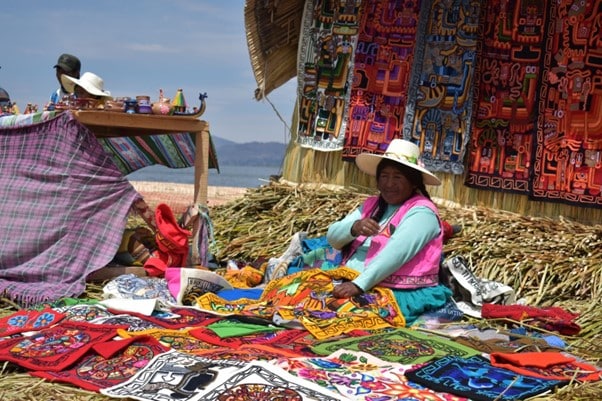
Take Extra Cash with You
Most islanders make a living selling their crafts. Expect to be presented with wall hangings, cushion covers, and other handicrafts.
Shopping may not be your reason for visiting, but it's worth taking a look. The craftsmanship on these products is exquisite. I enjoyed learning about the symbolism in the colorful designs. It's a great chance to practice your Spanish too!
Please Note: With intricate embroideries, it can take a woman more than three months to make a single item. Keep this in mind before haggling on prices.
You can pay extra for a short ride on a traditional reed boat. It costs about 10 soles, and the money goes directly to the island family. It's okay, maybe not the most amazing experience. Still, it's a small fee and if you are already there, you might as well do it.
If you are the generous sort, take lots of small change. Musicians and singing children will be hoping for a coin or two. Taking some sweets or fruit for the kids is also a nice idea.
